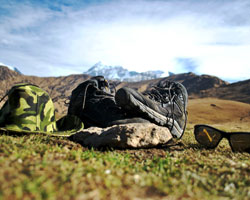If you're looking to notch your first 6000M summit, Yunam Peak Trek (6,111M) in Himachal’s Lahaul district should be on your radar. Tucked away in an arid corner of the Indian Himalayas, this lesser-known giant is approachable, not overly technical, and boasts a high success rate. The weather is relatively stable, and the route doesn't throw in too many surprises.
But let’s be clear: just because it’s doable doesn’t mean it’s easy. This one still demands respect. And sweat. Exactly what you'd expect from a real Himalayan experience.
This article will walk you through the challenges of climbing Yunam Peak, so you show up prepared, physically and mentally.

Trek Difficulty: BRS Level 6
Yunam Peak is rated Level 6 on the Bikat Rating Scale (BRS).
About the BRS: Our Bikat Rating Scale ranks treks and expeditions based on terrain, altitude, isolation, and technical demands. BRS 6 is your entry point to serious expeditions. Read more about the BRS here.
-
Beginners need not apply.
-
Prior experience with BRS 5 treks is mandatory.
-
High-altitude exposure and rapid gain make this more about acclimatization than skill.

Why Yunam Peak Is Tough (and Worth It)
1. Reaching the Trailhead: The Journey Before the Journey
Yunam starts from Bharatpur, a tiny outpost on the Manali-Leh highway, around 200 km from Manali. But even Manali is a mission to get to—no trains, no flights, just a 12-hour drive from Delhi. We split the approach across two days for acclimatization: Manali → Jispa → Bharatpur (4,700M).
Time-consuming? Yes. But also beautiful. On the way, you pass scenic hamlets like Sissu and Jispa, and witness Deepak Tal, Suraj Tal, and Baralacha La—a 4,850M pass that sets the tone for what's coming.
2. Altitude Gains That Outrun Your Lungs
Here’s what the elevation chart looks like:
| Day | From | To | Elevation Gain |
|---|---|---|---|
| 1 | Home (0–600M) | Manali (2,050M) | ↑ ~2,000M |
| 2 | Manali | Jispa (3,200M) | ↑ 1,150M |
| 3 | Jispa | Bharatpur (4,700M) | ↑ 1,500M |
| 4 | Acclimatization | Stay at Bharatpur | — |
| 5 | Bharatpur | Base Camp (5,200M) | ↑ 500M |
| 6 | Acclimatization | Stay at Base Camp | — |
| 7 | Base Camp | Summit (6,111M) | ↑ 911M |
That’s sea level to 6000M in just 7 days.
Compare that to:
-
Kang Yatse II: 6000M reached on Day 9
-
Deo Tibba: Day 12
-
Black Peak: Day 13
Yunam gives your body no time to adapt. Acclimatization breaks at Bharatpur and Base Camp help, but you still need to stay active and hydrated—no room for laziness.
3. Minimal Trekking = Maximum Self-Motivation
Out of 8 total days, only 3 involve actual trekking:
-
Bharatpur to Base Camp
-
Summit Day
-
Return to Bharatpur
The rest are travel or acclimatization days, where movement is optional but critical. Unlike other treks where the trail keeps you active, here you have to push yourself to move. Stay inside your tent too long, and altitude might catch you off guard.
4. The Dry, Brutal Beauty of Lahaul
Lahaul isn’t exactly gentle. It’s:
-
Barren
-
Dry
-
Unforgiving
With no vegetation and high elevation, the air is thin and dry, leading to cracked lips, dry throat, sunburn, and quick dehydration. There’s also zero shade, so UV protection is crucial. The terrain? Hard-packed dirt, loose rocks, and scree. But if you follow the defined trail, it's manageable.
5. Summit Day = Long, Steep, and Ruthless
The summit push is a proper test. You gain almost 1,000M of elevation in one go.
-
If it’s dry: Traction is better, but the trail feels longer.
-
If it’s snowed in: Footing gets trickier, pace slows down, and every step takes triple the effort.
Views of the Chandrabhaga Range reward the grind. But the wind, cold, and altitude will make you earn every frame.
6. The Fake Summit Illusion
From Base Camp, the summit looks teasingly close. But it's a false summit. Once you reach it, another steep ridge appears—the actual summit, still 2 hours away.
This psychological curveball has crushed many climbers. Manage your expectations and keep reserves in the tank.

Gear Checklist
Your gear is your safety net. Essentials include:
-
Backpack (50-60L): Comfortable, light, and load-balanced
-
Trekking Shoes: High-ankle, tough sole, waterproof if possible
-
Layered Clothing: Thermals, fleece, down jacket, rain shell
-
Sunglasses (UV 400+): Mandatory for snow glare
Useful reads:

Skills You’ll Learn
At Bikat, trekking is education on foot. For Yunam, we teach:
-
Trail movement techniques: Ascents, descents, pacing
-
Icecraft basics: Use of microspikes, self-arrest, walking on snow
-
Efficient packing: Makes or breaks your day
-
Tent pitching & campsite setup
-
Environmental ethics: Waste management, Leave No Trace
Prep reads:

Final Word
Yunam isn’t the flashiest 6000er. But it’s real. No pampering. No frills. Just an honest mountain that rewards honest effort.
If you want your first big summit to be raw, memorable, and earned the hard way, Yunam is your mountain.






